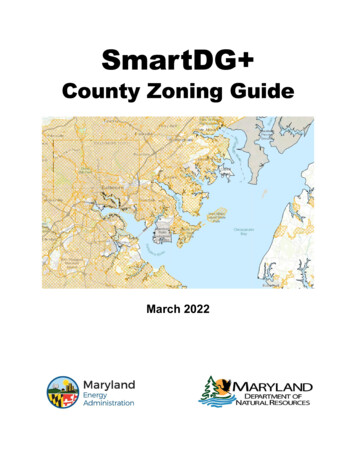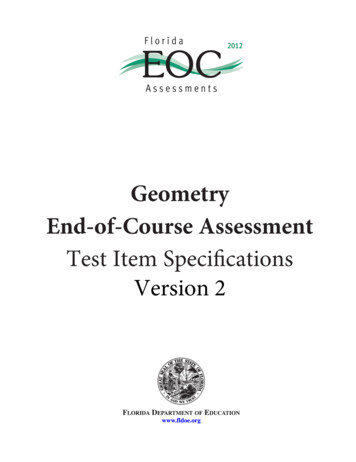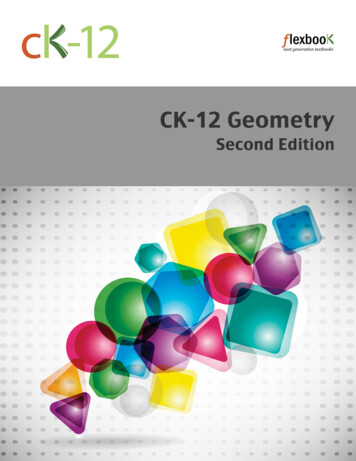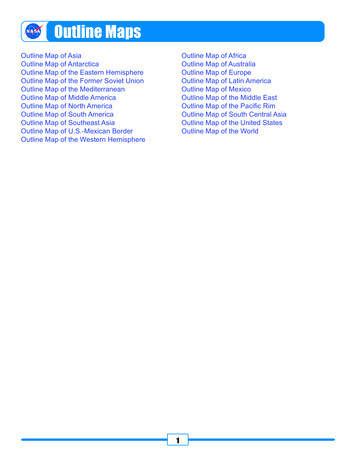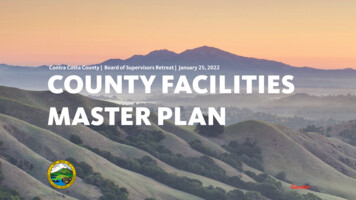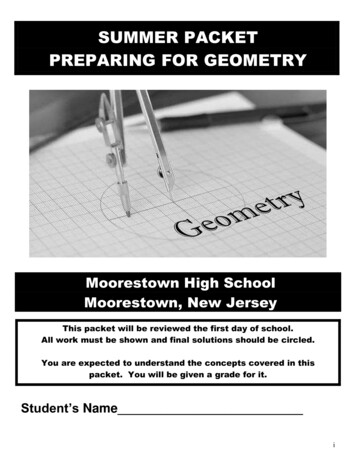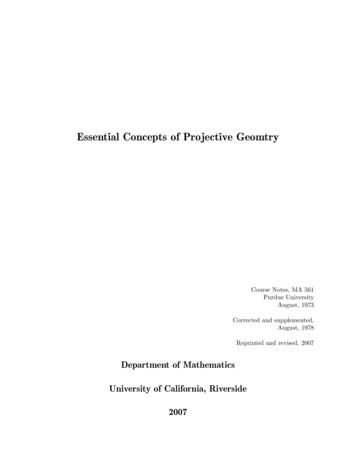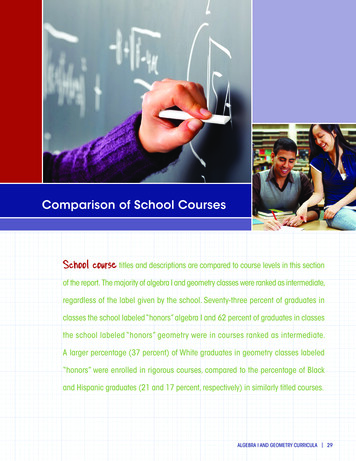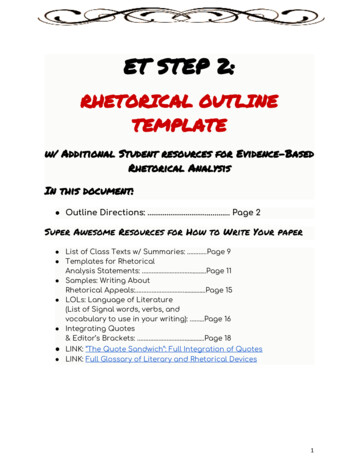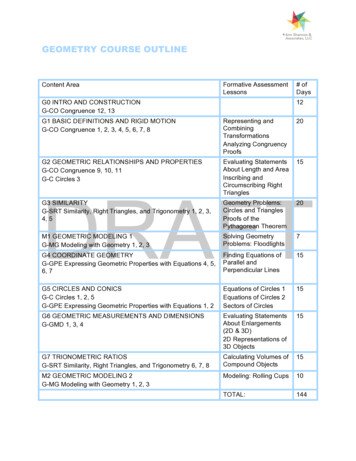
Transcription
GEOMETRY COURSE OUTLINEContent AreaFormative AssessmentLessonsG0 INTRO AND CONSTRUCTIONG-CO Congruence 12, 13# ofDays12G1 BASIC DEFINITIONS AND RIGID MOTIONG-CO Congruence 1, 2, 3, 4, 5, 6, 7, 8Representing andCombiningTransformationsAnalyzing CongruencyProofs20G2 GEOMETRIC RELATIONSHIPS AND PROPERTIESG-CO Congruence 9, 10, 11G-C Circles 3Evaluating StatementsAbout Length and AreaInscribing andCircumscribing RightTriangles15G3 SIMILARITYG-SRT Similarity, Right Triangles, and Trigonometry 1, 2, 3,4, 5Geometry Problems:Circles and TrianglesProofs of thePythagorean Theorem20M1 GEOMETRIC MODELING 1G-MG Modeling with Geometry 1, 2, 3Solving GeometryProblems: Floodlights7G4 COORDINATE GEOMETRYG-GPE Expressing Geometric Properties with Equations 4, 5,6, 7Finding Equations ofParallel andPerpendicular Lines15G5 CIRCLES AND CONICSG-C Circles 1, 2, 5G-GPE Expressing Geometric Properties with Equations 1, 2Equations of Circles 1Equations of Circles 2Sectors of Circles15G6 GEOMETRIC MEASUREMENTS AND DIMENSIONSG-GMD 1, 3, 4Evaluating StatementsAbout Enlargements(2D & 3D)2D Representations of3D Objects15G7 TRIONOMETRIC RATIOSG-SRT Similarity, Right Triangles, and Trigonometry 6, 7, 8Calculating Volumes ofCompound Objects15M2 GEOMETRIC MODELING 2G-MG Modeling with Geometry 1, 2, 3Modeling: Rolling Cups10TOTAL:144
HIGH SCHOOL OVERVIEWAlgebra 1GeometryAlgebra 2A0 IntroductionG0 Introduction andConstructionA0 IntroductionA1 Modeling With FunctionsG1 Basic Definitions and RigidMotionA1 Exponential FunctionsA2 Linear FunctionsG2 Geometric Relationshipsand PropertiesA2 Trigonometric FunctionsA3 Linear Equations &Inequalities in One VariableG3 SimilarityA3 FunctionsModeling Unit 1M1 Geometric Modeling 1Modeling Unit 1A4 Linear Equations &Inequalities in Two VariablesG4 Coordinate GeometryA4 Rational and PolynomialExpressionsA5 Quadratic FunctionsG5 Circles and ConicsP1 ProbabilityA6 Quadratic EquationsG6 Geometric Measurementsand DimensionsS2 StatisticsS1 StatisticsG7 Trigonometric RatiosModeling Unit 2Modeling Unit 2M2 Geometric Modeling 21. Make sense of problemsand persevere in solvingthem.4. Model with mathematics.7. Look for and make use ofstructure.2. Reason abstractly andquantitatively.5. Use appropriate toolsstrategically.8. Look for and expressregularity in repeatedreasoning.3. Construct viable argumentsand critique the reasoning ofothers.6. Attend to precision.
G0 INTRO AND CONSTRUCTION12 DAYSIn the CCSS for grades 6 and 7, students are asked to draw triangles and other polygons basedon given measurements, and they begin to investigate relationships within the figures that arethe basis for geometric postulates and theorems. In high school, students apply reasoning tocomplete geometric constructions and use properties of angles and segments to explain whythe constructions work. They develop their visual recognition and vocabulary, which provides anessential foundation for further study of geometric theorems and relationships. By copyingsegments and angles and constructing congruent figures, the students deepen theirunderstanding of congruence as it relates to the superposition principle (the placement of oneobject ideally in the position of another one in order to show that the two coincide). The focushere is not only on the motor skills and methods of construction, but on providing opportunitiesfor students to deepen their understanding of the inherent properties that define geometricfigures and the relationships between those properties.Congruence G-CO12. Make formal geometric constructions with a variety of tools and methods (compass and straightedge,string, reflective devices, paper folding, dynamic geometric software, etc.). Copying a segment; copyingan angle; bisecting a segment; bisecting an angle; constructing perpendicular lines, including theperpendicular bisector of a line segment; and constructing a line parallel to a given line through a pointnot on the line.13. Construct an equilateral triangle, a square, and a regular hexagon inscribed in a circle.TEACHING AND ASSESSMENT thematics.org/GEOMETRY COURSE OUTLINE —1
G1 BASIC DEFINITIONS AND RIGID MOTION20 DAYSThe CCSS calls for students to define and understand congruence through the perspective ofgeometric transformations. Fundamental to this perspective are the rigid motions: translations,reflections, and rotations, all of which preserve distance and angle measure. Students explainthe basis of rigid motions using geometric concepts, such as distance, movement along aparallel line, and movement along a circular arc with a specified center through a specifiedangle. They also build on their experience with rigid motions from earlier grades and deepentheir understanding of what it means for two geometric figures to be congruent. Rigid motionsand their properties are used to establish the criteria for triangle congruence, which are usedlater to prove other geometric theorems.Congruence G-CO1. Know precise definitions of angle, circle, perpendicular line, parallel line, and line segment, based onthe undefined notions of point, line, distance along a line, and distance around a circular arc.2. Represent transformations in the plane using, e.g., transparencies and geometry software; describetransformations as functions that take points in the plane as inputs and give other points as outputs.Compare transformations that preserve distance and angle to those that do not (e.g., translation versushorizontal stretch).3. Given a rectangle, parallelogram, trapezoid, or regular polygon, describe the rotations and reflectionsthat carry it onto itself.4. Develop definitions of rotations, reflections, and translations in terms of angles, circles, perpendicularlines, parallel lines, and line segments.5. Given a geometric figure and a rotation, reflection, or translation, draw the transformed figure using,e.g., graph paper, tracing paper, or geometry software. Specify a sequence of transformations that willcarry a given figure onto another.6. Use geometric descriptions of rigid motions to transform figures and to predict the effect of a given rigidmotion on a given figure; given two figures, use the definition of congruence in terms of rigid motions todecide if they are congruent.7. Use the definition of congruence in terms of rigid motions to show that two triangles are congruent if andonly if corresponding pairs of sides and corresponding pairs of angles are congruent.8. Explain how the criteria for triangle congruence (ASA, SAS, and SSS) follow from the definition ofcongruence in terms of rigid motions.FORMATIVE ASSESSMENT LESSONSRepresenting and Combining TransformationsThis lesson is about isometries (transformations that preserve distance, also called rigid motionsor congruence transformations) in the plane: translations, rotations about a fixed point, andreflections across a line. Students need to figure out the image of specific points, of a genericpoint (x,y), and of certain given figures in the coordinate plane under these types oftransformations. Given two congruent figures, they are also asked to find a transformation thatmaps one onto the other. They also need to figure out and describe the composition of two ormore of these transformations. Translations are described by the horizontal and verticaldisplacements that form the displacement vector. Reflections are described by specifying anequation for the line of reflection. Rotations are described by the coordinates of their center, themagnitude of their angle of rotation, and the direction of rotation (clockwise orGEOMETRY COURSE OUTLINE —2
counterclockwise). Students need to be familiar with the Cartesian coordinate plane. They needto be able to find points with given coordinates, find the coordinates of given points, graph linearequations, and find equations for given lines.Analyzing Congruency ProofsIn this lesson, students need to decide if two triangles sharing a given number of side lengthsand a given number of angle measures must be congruent. First they are asked about threespecific examples, and then they are provided with nine cards, each of them stating that twotriangles share n side lengths and m angle measures, where n is 1, 2 or 3 and m is 0, 1 or 2.Hence they have nine cards (all combinations above are given). For each card, they need todecide if the triangles must be congruent or not. In the former case, they must prove it, and inthe latter case they must give find a counter example, and if possible in a few cases, a furtherexplanation of why the conditions are not the same as ASA or SAS conditions that do guaranteecongruence. For this point, students must understand that the order of the corresponding sidesand angles in ASA and SAS matters.In order for students to access this lesson, they need to know some basic logic, like the fact thatone counterexample is enough to establish the falsehood of a (universal) statement, while usinginductive reasoning based on any number of confirming examples is not enough to prove such astatement. They also need to know the basic triangle congruence theorems, SSS, SAS, ASA,and they need to know that SSA or AAS is not sufficient for congruence (although it IS sufficientin SSA if the angle is opposite the longer side, a result little known in school). Students alsoneed to know similarity conditions, most crucially AA, and of course the fact that since alltriangles share the same angle sum of 180 degrees, sharing two angle measures is equivalentto sharing all three of them.TEACHING AND ASSESSMENT thematics.org/GEOMETRY COURSE OUTLINE —3
G2 GEOMETRIC RELATIONSHIPS AND PROPERTIES15 DAYSStudents use triangle congruence and their experience with geometric construction as afoundation for the development of formal proof. They explore various ways of writing proofs,including paragraph proofs, flow charts, two-column proofs, and labeled diagrams. Students areencouraged to focus on the validity of the underlying reasoning while they apply the differentmethods of formal proof. It is imperative that this unit include sufficient opportunities fordiscussion, reflection, student dialogue, and argument as students develop a deeperunderstanding of what constitutes a convincing proof. Through the practice of writing formalproofs, students extend their understanding and vocabulary with respect to the properties oflines, angles, triangles and quadrilaterals.Congruence G-CO9. Prove theorems about lines and angles. Theorems include: vertical angles are congruent; when atransversal crosses parallel lines, alternate interior angles are congruent and corresponding angles arecongruent; points on a perpendicular bisector of a line segment are exactly those equidistant from thesegment’s endpoints.10. Prove theorems about triangles. Theorems include: measures of interior angles of a triangle sum to180 ; base angles of isosceles triangles are congruent; the segment joining midpoints of two sides of atriangle is parallel to the third side and half the length; the medians of a triangle meet at a point.11. Prove theorems about parallelograms. Theorems include: opposite sides are congruent, oppositeangles are congruent, the diagonals of a parallelogram bisect each other, and conversely, rectanglesare parallelograms with congruent diagonals.Circles G-C3. Construct the inscribed and circumscribed circles of a triangle, and prove properties of angles for aquadrilateral inscribed in a circle.FORMATIVE ASSESSMENT LESSONSEvaluating Statements about Length and AreaThis lesson is about Geometry. More specifically, it is about the perimeter and area of differentkinds of figures: quadrilaterals, triangles, and circles. Students need to decide if certainstatements are always, sometimes, or never true. They need to prove their assertions. Whenthe statements are always or never true, the proof is done by providing an argument that appliesto any figure of the kind being considered. When the statement is sometimes true, studentsneed to find out examples, counterexamples, and, more importantly, the extent to which thestatement is true. That is, they need to restrict the set of figures being considered so that thestatement will always be true for those figures, and false for others.In order to do this lesson, students need to be familiar with formulas for perimeter and area oftriangles, trapezoids, parallelograms and circles. They also need some experience proving anddisproving geometric statements. That is, they need some experience with logical reasoningand proof. They also need to know the congruence theorems for triangles, basic facts about theproperties of parallelograms, and the fundamental theorem of similarity. Finally, students mayGEOMETRY COURSE OUTLINE —4
need to draw in additional supporting lines, which are not given in the figures, but they are givenin the hints.Inscribing and Circumscribing Right TrianglesThis is a lesson about finding the radii of both the circumscribed and the inscribed circles of aright triangle. Students are asked to find them in a specific example, a 5-12-13 triangle that isnot drawn to scale, and later they need to generalize their results to arbitrary right triangles.Besides the usual small group collaboration, they are given a few questions to reflect on howthey did individual and collaborative work.There are a few different ways to solve the problem. In order to do that, and to evaluate thesample student work that is given to students, they need to be familiar with the circle andtriangle theorems of Geometry. Four circle theorems are provided, two of which are mostrelevant here: the one about the measure of an inscribed angle being half the measure of thecorresponding central angle, and the one stating that tangent segments from a common pointare congruent. Some of the triangle theorems and other supporting Geometry facts thatstudents should know and be able to apply to this problem are the definition of distancebetween a point and a line; that a point on an angle bisector is equidistant from the sides of theangle; that the angle bisectors of a triangle are concurrent; that every triangle has a uniquecircumscribed circle (its center is the point of concurrency of the perpendicular bisectors of thesides); that every triangle has a unique inscribed circle (its center is the point of concurrency ofthe angle bisectors of its angles); and the formula for the area of a triangle given a side and thealtitude from the opposite vertex.TEACHING AND ASSESSMENT tivemathematics.org/The following tasks can be found at http://map.mathshell.org/materials/index.phpNovice TasksApprentice TasksExpert TasksA10: Floor PatternsE09: Triangular FrameworksGEOMETRY COURSE OUTLINE —5
G3 SIMILARITY20 DAYSStudents build on their experience with proportional reasoning and dilation from grades 7 and 8to establish a formal understanding of similarity. As congruence is approached from theperspective of rigid motions, similarity is examined from the perspective of similaritytransformations (dilations or rigid motions followed by dilations). Students investigate and verifythe effects of dilation on the properties of parallelism and segment length, and relate theseeffects to the center and scale factor of dilation. They also identify criteria for the similarity oftriangles, use the definition of similarity to determine if two figures are similar, and use similarityto solve problems. Students are expected to understand and explain similarity in figures fromthe perspective of similarity transformations, and to use the properties of similaritytransformations to establish triangle similarity theorems.Similarity, Right Triangles, and Trigonometry G-SRT1. Verify experimentally the properties of dilations given by a center and a scale factor:1a. A dilation takes a line not passing through the center of the dilation to a parallel line, and leaves a linepassing through the center unchanged.1b. The dilation of a line segment is longer or shorter in the ratio given by the scale factor.2. Given two figures, use the definition of similarity in terms of similarity transformations to decide if theyare similar; explain using similarity transformations the meaning of similarity for triangles as the equalityof all corresponding pairs of angles and the proportionality of all corresponding pairs of sides.3. Use the properties of similarity transformations to establish the AA criterion for two triangles to besimilar.4. Prove theorems about triangles. Theorems include: a line parallel to one side of a triangle divides theother two proportionally, and conversely; the Pythagorean Theorem proved using triangle similarity.5. Use congruence and similarity criteria for triangles to solve problems and to prove relationships ingeometric figures.FORMATIVE ASSESSMENT LESSONSGeometry Problems: Circles and TrianglesThis Geometry lesson asks for the ratio of the areas of two equilateral triangles, onecircumscribed and the other inscribed in a given circle. Then it asks for the ratio of the areas oftwo circles, one circumscribed and one inscribed in a given equilateral triangle.There are many different possible solutions. Students may use or derive facts about equilateraltriangles, like the fact that their medians cut each other in segments of ratio 2 to 1. Dependingon their approach, they may need some basic right-triangle trigonometry, or else knowledge ofthe ratio of side lengths of 30-60-90 triangles. They may need to know how to derive the area ofan equilateral triangle given its side length, and they may need to know the formula for the areaof a circle. They may also need to know about similarity and the effect on areas upon scaling bya given factor. They may use rotations and triangle congruence theorems. Finally, students areasked to examine carefully and criticize several sample solutions for correctness, clarity, andcompleteness.Proofs of the Pythagorean TheoremIn this lesson, students need to use diagrams provided to them in order to prove thePythagorean theorem in different ways. They also need to analyze, evaluate and correctdifferent proofs that may have mistakes, given as sample student work. Together, they provideGEOMETRY COURSE OUTLINE —6
several different ways to prove the theorem. Students need to be able to translate back andforth between the visual information of the geometric diagrams and the algebraic relationshipsthat they reveal, through the consideration of lengths, areas, congruence and similarity. Theyalso need to be able to explain why a geometric figure really is what it looks like in a diagram(for example, a square or a trapezoid) by considering lengths and angles. They have to be ableto label lengths of segments in a useful way, and to visualize how one diagram can be changedinto another by moving around congruent pieces, in order to represent certain quantities in twodifferent ways.TEACHING AND ASSESSMENT tivemathematics.org/The following tasks can be found at http://map.mathshell.org/materials/index.phpNovice TasksApprentice TasksExpert TasksE04: Proofs of the PythagoreanTheoremE08: Pythagorean TriplesE15: Circles and SquaresGEOMETRY COURSE OUTLINE —7
M1 GEOMETRIC MODELING 17 DAYSThis unit is intended to provide students with an opportunity to apply geometric concepts inmodeling situations. Students choose and use appropriate geometric tools and concepts toanalyze empirical situations. Modeling allows the students to understand the situation better andto improve decision-making and interpretation. This could include using geometric shapes torepresent objects, using geometric concepts to represent situations, or using geometricmethods to solve design problems.Modeling with Geometry G-MG1. Use geometric shapes, their measures, and their properties to describe objects (e.g., modeling a treetrunk or a human torso as a cylinder).2. Apply concepts of density based on area and volume in modeling situations (e.g., persons per squaremile, BTUs per cubic foot).3. Apply geometric methods to solve design problems (e.g., designing an object or structure to satisfyphysical constraints or minimize cost; working with typographic grid systems based on ratios).FORMATIVE ASSESSMENT LESSONSSolving Geometry Problems: FloodlightsIn this lesson, students are asked to solve a geometric problem given in context, as a wordproblem. A person stands between in the middle between two floodlights that are at the sameheight. Students need to find the length of the shadows and hence the total length of the twoshadows. Then the person starts moving toward one of the floodlights, and students are askedto explain what happens to this total length. First of all, students need to be able to model thissituation with an appropriate geometric picture. They also need to recognize that the key to theproblem (that the length of the combined shadows remains constant) is similar triangles, andonce they find useful similar triangles, they need to use the facts about ratios of correspondingsides being equal. In order to establish the similarity of the triangles, students need to know thatopposite sides of a rectangle are parallel, that alternate interior angles cut by a transversal totwo parallel lines are equal, and that triangles sharing two angle measures are similar.TEACHING AND ASSESSMENT thematics.org/GEOMETRY COURSE OUTLINE —8
G4 COORDINATE GEOMETRY15 DAYSStudents use the coordinate plane and algebra to verify geometric relationships. This is anextremely important unit, as it provides students with the opportunity to refine theirunderstanding of basic geometric theorems through empirical investigation, experiment, andalgebraic proof. Applications of slope extend and strengthen student experiences from 9 thgrade, and deepen conceptual understanding of parallel and perpendicular lines and theproperties of quadrilaterals. Students build on their work with the Pythagorean theorem from 8 thgrade by using distance to investigate geometric figures and solve problems.Expressing Geometric Properties with Equations G-GPE4. Use coordinates to prove simple geometric theorems algebraically. For example, prove or disprove thata figure defined by four given points in the coordinate plane is a rectangle; prove or disprove that thepoint (1, 3) lies on the circle centered at the origin and containing the point (0, 2).5. Prove the slope criteria for parallel and perpendicular lines and use them to solve geometric problems(e.g., find the equation of a line parallel or perpendicular to a given line that passes through a givenpoint).6. Find the point on a directed line segment between two given points that partitions the segment in agiven ratio.7. Use coordinates to compute perimeters of polygons and areas of triangles and rectangles, e.g., usingthe distance formula.FORMATIVE ASSESSMENT LESSONSFinding Equations of Parallel and Perpendicular LinesIn this lesson students need to find, among a list of linear equations, the four equations whosegraphs intersect forming a rectangle. They also need to find, among a list of equations, whichcorresponding lines share the same y-intercept, which share the same x-intercept, which areparallel, which are perpendicular, and which go through a specified common point. Studentsneed to know how to graph lines in the coordinate plane given a linear equation in two variables.They need to be able to find an equation for a given line in the plane, given two points or given apoint and the slope. They also need to manipulate and transform linear equations of lines intothe different equivalent forms: standard, point-slope, and slope-intercept. Students need toknow the relationship between the slopes of parallel lines and of perpendicular lines.TEACHING AND ASSESSMENT tivemathematics.org/The following tasks can be found at http://map.mathshell.org/materials/index.phpNovice TasksApprentice TasksExpert TasksA22: SquareGEOMETRY COURSE OUTLINE —9
G5 CIRCLES AND CONICS15 DAYSIn this unit, students prove and apply theorems about circles. They also examine how central,inscribed and circumscribed angles relate to chords, radii, and arcs of the circle. The idea ofradian measure is introduced through the idea that all circles are similar, and the fact that thesimilarity of all sectors with the same central angle shows that arc length is proportional to theradius. By using similarity as the basis of this topic, students will have a more completeconceptual framework upon which to place the idea of radian measure, and a more reliable wayto reconstruct the idea. Students also extend their thinking about the Pythagorean theorem andcoordinate distance to write the equation of a circle given the center and radius, and to graph acircle given its equation. Students are expected to translate between the geometric descriptionand the equation of a circle and a parabola.Circles G-C1. Prove that all circles are similar.2. Identify and describe relationships among inscribed angles, radii, and chords. Include the relationshipbetween central, inscribed, and circumscribed angles; inscribed angles on a diameter are right angles;the radius of a circle is perpendicular to the tangent where the radius intersects the circle.5. Derive using similarity the fact that the length of the arc intercepted by an angle is proportional to theradius, and define the radian measure of the angle as the constant of proportionality; derive the formulafor the area of a sectorExpressing Geometric Properties with Equations G-GPE1. Derive the equation of a circle of given center and radius using the Pythagorean Theorem; complete thesquare to find the center and radius of a circle given by an equation.2. Derive the equation of a parabola given a focus and directrix.FORMATIVE ASSESSMENT LESSONSEquations of Circles 1In this lesson, students need to find an equation for a circle given some information about itsgraph; for example, two endpoints of a diameter or the center and radius. They also need to beable to graph a circle given an equation for it, and find the possible coordinates of a point on thecircle given the other coordinate. The equations are all given (with only minor changes like theorder of the terms) in the form where the squares have been completed, so that the center andradius are immediate from the equation. Students are given several such equations, and theyhave to post each one in the corresponding entry of a chart that is a matrix with different centersand radii. In order to understand the lesson and find points on circles, as well as the equations,students need to know the Pythagorean theorem and the distance formula, be familiar with theCartesian (coordinate) plane, and be able to manipulate square roots.Equations of Circles 2This lesson is also about circles and is similar to Equations of Circles 1. Roughly the sameskills, knowledge and ability are necessary. Again the equations given or asked for are alreadyGEOMETRY COURSE OUTLINE —10
in completed squares. In this lesson, students need to find the x- and y- intercepts (if any) ofcircles, and then given several equations or graphs, they need to place each in a chart that is amatrix with the number of x- and of y- intercepts that a circle may have (0, 1, or 2). They alsoneed to find equations for circles having certain properties and a given number of x- and yintercepts, and they have to explain why the equations they come up with produce circles withthe required properties. Another task of the lesson involves considering three circles and findingdifferent criteria under which any one of them could be considered the odd one out.Sectors of CirclesIn this lesson, students study sectors of circles, paying attention to their angle, radius, arclength, and area. Students are led through a discussion of radians, arc length, and area ofsectors. They need to find the formulas for arc length and area by understanding how the angleof the sector determines the fraction of a circle that it makes up, and then use proportionalreasoning together with the formulas for the circumference and area of a circle. Given threeconcentric circles with specified radii (in the ratio 1:2:4), they need to find different sectors onany of the circles that have the same area or arc length. For this, they need to understand whathappens to lengths and areas when scaling figures. They also need to understand, using theformulas they obtained, how the arc length and area of a sector change with its angle and withits radius. Students need to sort domino cards into a loop, where half of each card is a sector(whose arc length, radius, perimeter and area they need to compute given one of thesequantities) and the other half is a set of instructions for changing or maintaining some of thesequantities. They also need to match each of four cards showing a sector and asking for ways todraw another sector with the same or with double the arc length or area, with two cards havinginstructions about changing the radius and changing the angle of the sector.TEACHING AND ASSESSMENT tivemathematics.org/The following tasks can be found at http://map.mathshell.org/materials/index.phpNovice TasksApprentice TasksN10: Expressing GeometricProperties with EquationsA13: Temple GeometryExpert TasksGEOMETRY COURSE OUTLINE —11
G6 GEOMETRIC MEASUREMENTS AND DIMENSIONS15 DAYSThe CCSS requires students in the middle grades to know and apply formulas for thecircumference and area of a circle and the volume of prisms, cones, cylinders, and spheres. Inthis course, as
the basis for geometric postulates and theorems. In high school, students apply reasoning to complete geometric constructions and use properties of angles and segments to explain why the constructions work. They develop their visual recognition and vocabulary, which provides an
